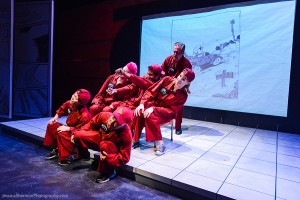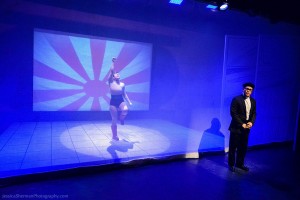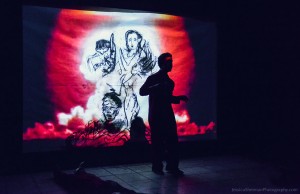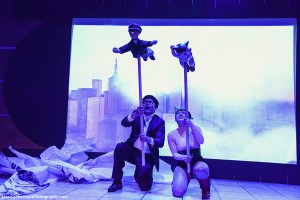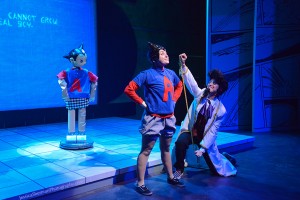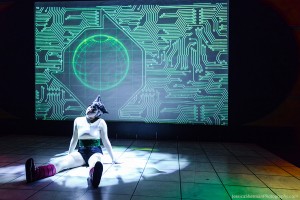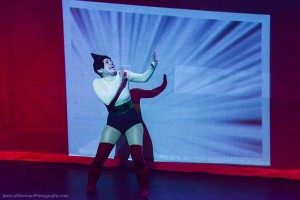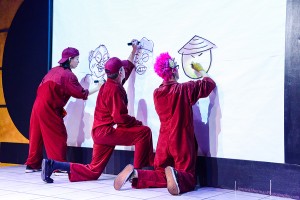SYNTHETICS AND STRUCTURE
Excelling at stage picture, Jaime Robledo sets a lot of toys in motion in Sacred Fools’ latest offering, recently extended into August. Robledo’s direction of Natsu Onoda Power’s 2011 spectacle Astro Boy and the God of Comics features scrims and screens, puppets, projections, live actors and plain old pen and paper, all interacting all the time. A boy robot flies through a cityscape and outer space to land in the heart of the sun; he fights monsters; he is assembled from spare parts, and disassembled, before your very eyes. It’s the kind of thing you can’t do naturalistically on a stage, but with the aid of a lot of skill and style, it happens here.
That this production looks very like the the play’s premiere production in Washington, D.C. – judging from production stills, right down to costumes and composition of bodies – isn’t necessarily a mark against the Fools’ creative spark. Astro Boy is a little akin to movies like Sin City and 300, the uber-faithful bigscreen versions of Frank Miller comics: these films, for better or worse, take great pains to recreate the frames of an original work. And Power’s play is so specific in its requirements, or at least so thorough in its visual invention, that staging it any other way right now might not even be a good idea.
At any rate, for this West Coast premiere, a rare team of designers has assembled under producer and technical supervisor Brian W. Wallis – Matt Richter’s lights make much of Linda Muggeridge’s bright, poppy costumes and DeAnne Millais’ clean, many-layered set (built by Joshua Benton, Bart Tangredi and many other talented craftspeople); Anthony Backman’s projection video and Jim Pierce’s projection animation integrate perfectly with Aviva Pressman’s live art direction, in which actors draw pictures that as often as not come to life.
The show is delightful to look upon, especially given that among these novelties soars a central performance by Heather Schmidt. In the physically rigorous role of a cartoon character described several times as “adorable,” Schmidt is suitably so, but also technically excellent – it’s not easy to hit prescribed mechanical marks with this much accuracy and pathos.
But at a little over an hour, this show is tedious about half the time, and Astro Boy’s absence from the middle of the play is a clue to the larger problem: The script is monumentally ill-conceived, dumb enough to abandon its only real character halfway through.
Power’s play apparently intends to tell the story of Osamu Tezuka, a towering figure in the Japanese comic form known as manga, using the excitement generated by his art. Instead Power begins at the end, sort of, with the final adventure of Tezuka’s signature creation, Astro Boy, and counts down backward to the birth and death of Tezuka himself. In between come sketches that, since we’re going backward and no plot or character can build in that direction, only create more blank canvas: A few bits of acted-out comic story, summarily dropped several minutes after they stop being interesting; a narrow-focus Japanese pop-culture history lesson; a micro-biography or two. Gorgeous as it is to look at, all of it left me wanting more – but not more of this, of which I wanted less.
- The device of the fragmented narrative only works when there’s a narrative to fragment; mixing up pieces of different narratives can work but only when they amount to a thematic whole. Here, watching a chunk of story that’s then dropped, unresolved, only adds up to frustration. What we learn of Astro Boy’s struggles tells us nothing of Tezuka.
- The device of reverse chronology only works when the revelation of the closing moment codifies, eulogizes, or illuminates what has gone before. Here, finding out at the end that a cinematic-comic artist had parents who were into photography and animation isn’t news. It’s like telling me that a newspaper publisher liked journalism when he was a kid. What we learn of Tezuka’s struggles tells us nothing of Astro Boy.
- Rising action is important even to non-narrative art. The mounting of events, the piling up of related circumstances, impetus and momentum: without these, Astro Boy and the God of Comics remains as static as its imagery is dynamic.
Besides Schmidt, whose in-and-out appearances as the titular robot-child are too few to build a show upon, the cast includes West Liang as a mostly talking-head Tezuka; it’s odd that a person described as an eccentric genius should be played in such a sedate, unremarkable manner, but so the show would have it. Of the swing cast, the always-irrepressible, in-danger-of-typecasting Marz Richards is lovely as always; Zach Brown and understudy Lisa Anne Nicolai also stand out.
I have not traditionally placed intimate scenes of character and dialogue among Robledo’s strengths as a director, but there aren’t any of those in this play. It’s all sound and fury, signifying sound and fury (excellent sound design by Robledo; original music by Ryan Johnson). I prefer when Robledo directs a show with a little something in the intellect and emotion department, but if you prefer bombast that manages to remain physically coherent and visually peppy, this is that.
photos by Jessica Sherman Photography
Astro Boy and the God of Comics
Sacred Fools Theater Company
660 N. Heliotrope
scheduled to end on August 8, 2015
for tickets, call (310) 281-8337 or visit www.sacredfools.org

